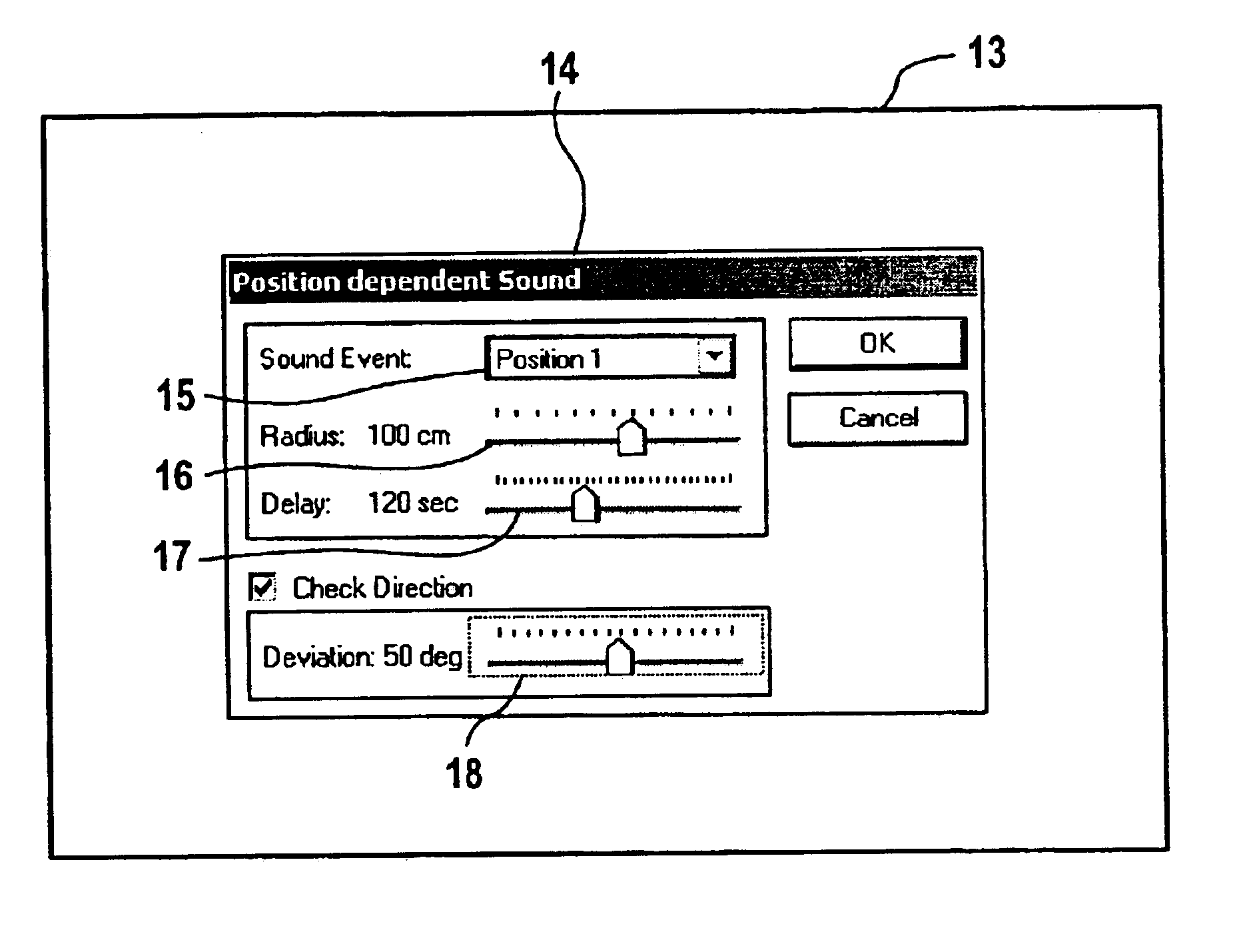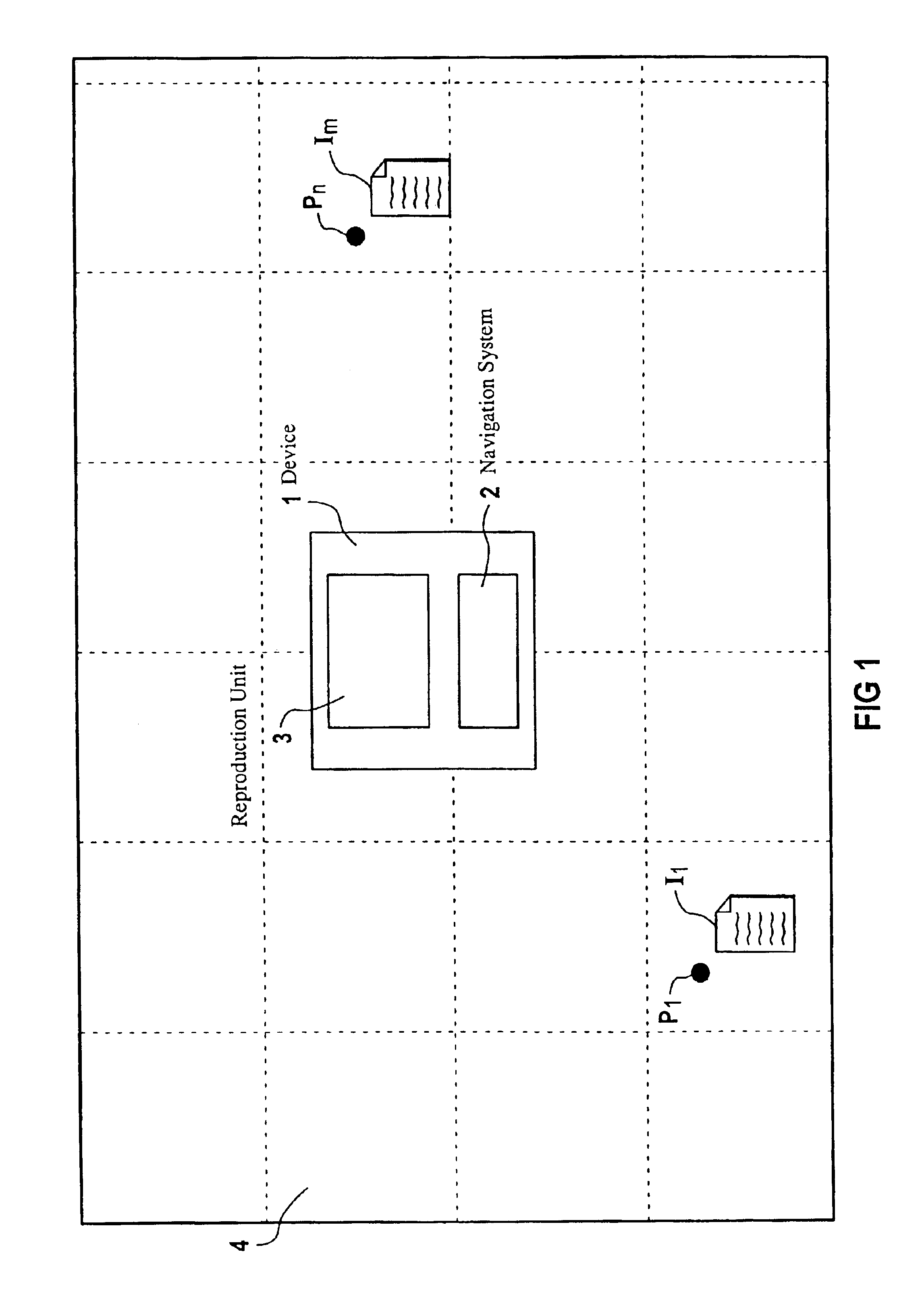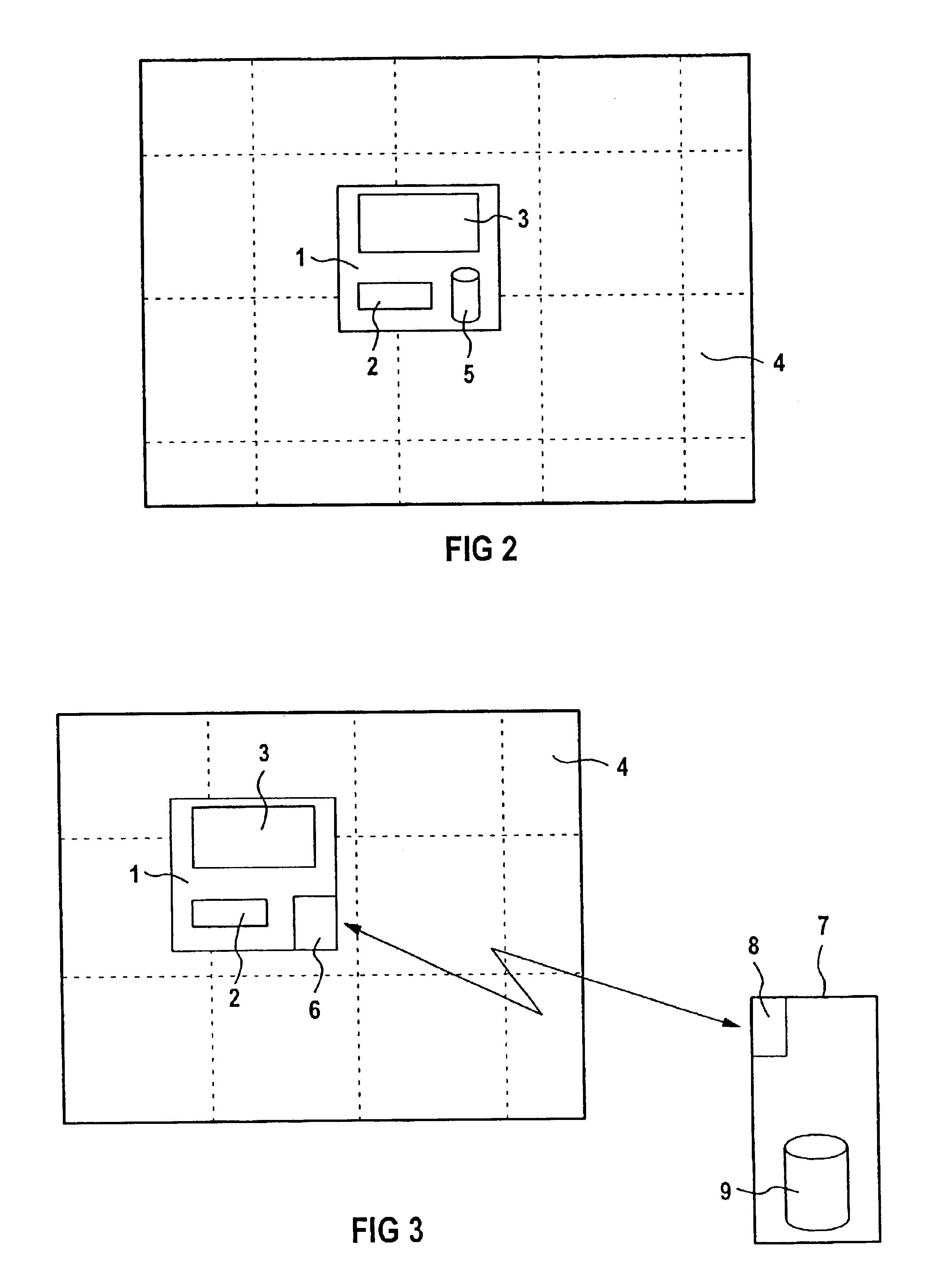[0008]The invention is based, inter alia, on the finding that it is increasingly important in an environment with a permanent glut of information to place the information relevant to a certain target group selectively and at suitable locations. For instance, it is very advantageous if advertisements for a certain product in a supermarket are made only in the vicinity of the product. This can be accomplished by means of static displays or posters, but these solutions take a lot of room. Furthermore, posters or displays must be installed or mounted and removed again after the promotion is finished. They may also be expensive to produce and dispose of or recycle. In the case of a supermarket chain, the posters or displays must be delivered to the individual branches from the place where they are manufactured. This involves shipping costs. An important
advantage of the invention is that a device for providing position-dependent predefinable information, which is used, for instance, on a cleaning
robot, provides special product-related information only in the vicinity of the corresponding product. Thus, the cleaning
robot can advantageously be used to advertise products in its surroundings. A shopping
cart actively moved by the user offers another possibility to provide information on products when the
cart is pushed into their vicinity.
[0009]A device according to the invention furthermore makes it possible to provide a user, who is actively moving in an environment with the device, with predefined, position-dependent information. This is advantageous especially in museums and at exhibitions. The exhibits need not be overloaded with explanatory text panels. The information associated with the exhibit is instead made available by the device specifically at the corresponding position. This has the advantages that the visitor can visually concentrate on the exhibit and is not distracted by explanatory information. With this specific provision of information it is also possible to support different languages for different users.
[0010]One advantageous embodiment of the invention is characterized in that the current position is determined in relation to a map established by a
navigation system. As a result, it is possible to use the position of the device as determined by means of a map of the surroundings, to provide the predefined, position-dependent information. The device preferably utilizes an orientation and map-producing method for mobile units to determine its current position within the environment. The device can, for instance, be a self-propelled device, e.g., a cleaning
robot, or a device that is moved by external forces, e.g., a shopping
cart or a portable device. The device provides specific, predefined information as a function of its current position with the aid of the playback (
reproduction) device.
[0011]A further advantageous embodiment of the invention is characterized in that the device can be configured in a variety of ways, to provide information to a user of the device, to a person who is not directly using the device, and / or to another device. This allows the information to be provided to any of a variety of different addressees. These can be anonymous persons who happen to pass by the information source and are shown position-dependent advertisements. The information may also be provided directly to users of the device, e.g., to customers pushing their shopping carts through a supermarket or to visitors of museums and exhibitions who are provided with the information associated with corresponding exhibits by means of a portable device. The inventive device can also be used to provide position-dependent information to a
machine or another device. For instance, a
mobile robot, which supplies components (diodes, resistors) for automatic component
insertion machines for PCBs directly to the
machine, provides the corresponding
machine with data, e.g., regarding the manufacturer, the part number, and the number of components delivered. Such a device according to the invention facilitates material tracking and thus has a positive
impact on
quality assurance. Because the automatic machine receives data regarding the number of units supplied, a message can be generated sufficiently in advance before the components are used up and a new delivery can be triggered. This avoids costly
downtime.
[0012]Another advantageous embodiment of the invention is characterized in that the play-back device supplies the predefined information in any of many different forms, including acoustic, visual, olfactible, and / or tangible form, and / or any other form that can be detected by man or machine. The play-back device can thus supply the predefined, position-dependent information in any of a wide range of different forms. One inventive embodiment of the play-back device is, for instance, a display mounted to or integrated into the device, a TV monitor, or some other device for reproducing visual information, such as e-paper (
electronic paper). In this type of an embodiment the play-back device provides the information in the form of texts or static or moving images. Another inventive embodiment of the play-back device is, for instance, a device for representing virtual or
augmented reality, which is provided position-dependent to the user or to a
third party that is not using the device directly. A maintenance
technician or mechanic in, e.g., a manufacturing or a production
plant is provided, for instance, with equipment-specific data. A further advantageous embodiment of the play-back device is, for instance, a
headset or some other device that supplies acoustic signals in such a way that they are received by the addressee. Texts that explain exhibits in museums or at exhibitions can be reproduced by the device in this manner, likewise acoustic orientation aids for the
hearing impaired, or instructions for orientation during movement in an obscure environment, such as sewer systems or mining tunnels. For an integrated sensory impression, e.g., in museums or at exhibitions, it is advantageous to provide a play-back device that supplies, solely or in addition, position-dependent olfactory signals such as fragrances, tactile signals such as vibrations, or sensible signals such as temperature changes. This makes it possible to reproduce environmental factors in a manner that is close to reality. If the information is to be provided for a machine or some other technical equipment, it is advantageous to use an embodiment of the invention that reproduces, for instance, predefinable information in digital or in some other machine-readable form.
[0013]A further advantageous embodiment of the invention is characterized in that the device incorporates a storage medium for storing the information, or that the device has a
transmitter /
receiver for receiving information transmitted to the device by means of a separate, stationary base unit. This gives the options either to store the predefined position-dependent information on a storage medium in the device itself or to store the information on a stationary base unit (
server) from where it can be transmitted to the device. The most advantageous and appropriate technical implementation of the invention in a given context will depend on the type and amount of information to be provided, and perhaps other factors.
 Login to View More
Login to View More  Login to View More
Login to View More 


